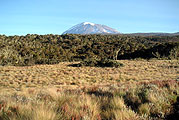 |
|
|
|
|
|
|
In certain areas, indirect effects of climate warming may be more important than direct effects. Front page newspaper reports on the disappearing ice cape of Kilimanjaro, the highest mountain of Africa, do not focus on the actual problem. Recent studies have clearly documented enhanced fire frequency in the upper montane forest belt of Kilimanjaro. Fire has induced a 300 m downward shift of the Ericaceae treeline. This has far more dramatic consequences for downslope life and hydrology than the loss of the glacier: More than 90 % of the hydrological consequences (water yield) is due to climate-induced loss of cloud forest and not due to the loss of the ice cap. |
|
1 - The remains of Kilimajaro's famous ice cap surrounded by ericaceous forest which could grow up to 4000 m elevation if there had not been the recent drought-induced fires. Wet moorlands in the foreground at 2600 m. |
2 - The last patches of Ericaceae elfin forest at 3700 m elevation. Most of this forest was lost quite recently (Fig. 3). |
3 - Massive tree stumps in burned upper montane forest land witness the former presence of a tall stature forest (here at 3800 m). |
|
As in most tropical mountains, precipitation peaks on Kilimanjaro between 2300 and 2800 m elevation. Above this belt, precipitation declines and gives way to a semiarid climate near treeline where fire risk may change rapidly with only small changes of precipitation. |
29 August 2011 |
||
| |
||


